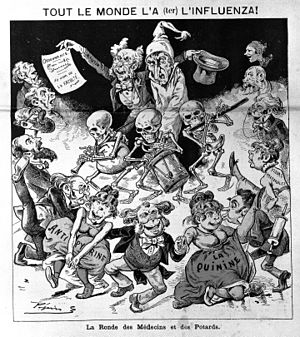Pandemik selesema 1889–1890

Pandemik selesema 1889-1890, juga dikenali sebagai "selesema Asiatik" atau "selesema Rusia", adalah pandemik influenza maut yang membunuh sekitar 1 juta orang di seluruh dunia.[1][2] Ia merupakan wabak besar terakhir abad ke-19.[3]
Kesan pandemik yang paling banyak dilaporkan berlaku pada Oktober 1889 - Disember 1890, dengan berulang pada bulan Mac - Jun 1891, November 1891 - Jun 1892, musim sejuk 1893-1894 dan awal tahun 1895.
Tidak diketahui secara pasti agen apa yang bertanggungjawab terhadap wabak tersebut. Sejak tahun 1950-an telah disangka sebagai subjenis virus Influenza A H2N2.[4] Kajian seroarkeologi tahun 1999 menegaskan baka sebagai subjenis virus Influenza A H3N8. Sebuah kajian virologi genomik tahun 2005 mengatakan bahawa bahawa virus itu sebenarnya bukan virus influenza, melainkan koronavirus manusia OC43.
Rujukan
[sunting | sunting sumber]- ^ Shally-Jensen, Michael, penyunting (2010). "Influenza". Encyclopedia of Contemporary American Social Issues. 2. ABC-CLIO. m/s. 1510. ISBN 978-0-31339205-4. Dicapai pada 25 March 2020.
The Asiatic flu killed roughly one million individuals
- ^ Williams, Michelle Harris (2015). "Influenza and Pneumonia Basics Facts and Fiction" (PDF). Maryland Department of Health - Developmental Disabilities Administration. University of Maryland. Pandemics. Diarkibkan daripada yang asal (PDF) pada 12 December 2017. Dicapai pada 25 March 2020.
Asiatic Flu 1889-1890 1 million
- ^ "The Last Great Uncontrolled Plague Of Mankind". Science Creative Quarterly. 30 October 2007. Dicapai pada 25 March 2020.
The Asiatic flu, 1889-1890: It was the last great pandemic of the nineteenth century.
- ^ Vijgen, Leen; Keyaerts, Els; Moës, Elien; Thoelen, Inge; Wollants, Elke; Lemey, Philippe; Vandamme, Anne-Mieke; Van Ranst, Marc (2005). "Complete Genomic Sequence of Human Coronavirus OC43: Molecular Clock Analysis Suggests a Relatively Recent Zoonotic Coronavirus Transmission Event". Journal of Virology. 79 (3): 1595–1604. doi:10.1128/JVI.79.3.1595-1604.2005. PMC 544107. PMID 15650185.
Bacaan lanjut
[sunting | sunting sumber]- Bäumler, Christian (1890). Ueber die Influenza von 1889 und 1890 [On the influenza of 1889 and 1890)] (dalam bahasa Jerman).
- Chisholm, Hugh, penyunting (1911). . Encyclopædia Britannica (dalam bahasa Inggeris). 14 (ed. ke-11). Cambridge University Press. m/s. 552–556.
- Parsons, Henry Franklin; Klein, Edward Emmanuel (1893). Further Report and Papers on Epidemic Influenza, 1889–92. Local Government Board. Dicapai pada 19 June 2013.
- Ziegler, Michelle (3 January 2011). "Epidemiology of the Russian flu, 1889–1890". Contagions: Thoughts on Historic Infectious Disease. Diarkibkan daripada yang asal pada 22 June 2013. Dicapai pada 19 June 2013.
Text is available under the CC BY-SA 4.0 license; additional terms may apply.
Images, videos and audio are available under their respective licenses.
